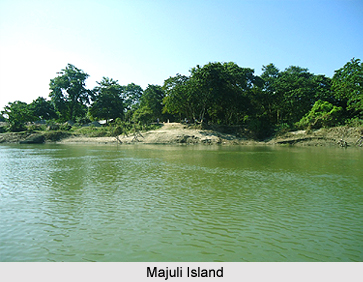 Tourism in Jorhat District includes several places of interest. The amazing sightseeing options of this district of Assam offer the tourists a pleasurable experience filled with adventure and tranquillity. In fact, there is no dearth of enjoyment options in Jorhat district. Some of the tourist attractions of Jorhat district include Majuli, Lachit Borphukan Maidam, Dhekiakhowa Bar Namghar, Bangalpukhari and more. Moreover, the tourism in Jorhat district offers the travellers from different parts of the world through pilgrimage as well as leisure tourism. The historical places of interest of Jorhat District reflect the rich past of the place.
Tourism in Jorhat District includes several places of interest. The amazing sightseeing options of this district of Assam offer the tourists a pleasurable experience filled with adventure and tranquillity. In fact, there is no dearth of enjoyment options in Jorhat district. Some of the tourist attractions of Jorhat district include Majuli, Lachit Borphukan Maidam, Dhekiakhowa Bar Namghar, Bangalpukhari and more. Moreover, the tourism in Jorhat district offers the travellers from different parts of the world through pilgrimage as well as leisure tourism. The historical places of interest of Jorhat District reflect the rich past of the place.
Pilgrimage Tourism in Jorhat District
Vaishnava Satras: The Vaishnava Satras were founded by Srimanta Sankaradeva, the father of Assamese culture. The historic and auspicious `Manikanchan Sanjog` was the first Satra in Majuli. Afterwards 65 more Satras grew which propagated the ethnic and socio-cultural ideals. At present, there are only 22 Satras in Majuli and rest have been shifted to other places owing to flood and erosion. These Satras are the treasure house of `Borgeet`, Matiakhara, Jumora dance, Chali dance, Noyua dance, Nande Vringee, Sutradhar, Ozapali, Apsara dance, Satria Krishna dance, Dashavatara Dance etc. which were contributed by Shri Sankaradeva.
Dakhinpat Satra: Dakhinpat Satra was established by Banamalidev, a supporter of Raslila, which is now observed as one of the prominent festivals of Assam.
Garamurh Satra: Lakshmikantadeva founded this Satra. During the end of autumn season traditional Raslila, is performed with great enthusiasm. Some ancient weapons are also preserved here.
Auniati Satra: Established by Niranjan Pathakdeva, this Satra is famous for `Paalnaam` and Apsara dance and it also has considerable collection of old Assamese utensils, jewellery and handicrafts.
Kamalabari Satra: Kamalabari Satra founded by Bedulapadma Ata, is a centre of art, culture, literature and classical studies. Its branch Uttar Kamalabari Satra has performed several cultural programme of satria art across the country and abroad.
Bengenaati Satra: This Satra is a storehouse of culturally important antiques and it is also described as an advanced centre of performing arts.
Nature Tourism in Jorhat District
Majuli: Majuli is the world`s biggest riverside island and a principal place of pilgrimage for the Vaishnavites of Assam since the Ahom age. Further, there are several Satras of Vaishnava religious beliefs. Of these holy seats, Auniati, Daksinpath, Garamur and Kamlabari are the four most prominent. What is of special importance is its Satra establishment, consisting of separate structures, which are built for different purposes.
Karanga: It is a village that caters to the demand of neighbouring tea estates and local people.
Nimati: Situated at a distance of around 17 km from Jorhat, it is an important river port of the district as well as of the upper Assam region.
Cinnamora Tea Estate: Cinnamora Tea Estate is the first tea garden of Assam established by Maniram Dewan in the year 1850.
Leisure Tourism in Jorhat District
Bangal Pukhari: On the southern side of Jorhat, near Na-ali, there is a tank that is popularly known as Bangalpukhari. Interestingly, people do not use the water of this tank.
Thengal Bhawan: Thengal Bhawan was build in the year 1880 by Raibahadur Shiva Prasad Barua. The first Assamese Daily "Dainik Batari" was started from this complex.
Kunwori Pukhari: About two Miles east of Jorhat town near the Grand Trunk Road there is a big tank which is known as Kunwori pukhari. This tank also has some historical importance associated with it.
Bilvesvar Shiva Temple: Around 35 km north of Jorhat town by the side of South Trunk Road, lies ruins of an old and small temple, along with a tank built by Rucinath Burgohain.
Gazpur: At a little distance towards north of Bilveswara temple the remains of Hathigarh can be seen. The Garh was erected to capture elephants. The king decided to make a town by collecting one thousand elephants. However, it was difficult to collect so many elephants. Therefore, the king gave up the idea and named the place as Gazpur.
Ladaigarh: King Pratap Sinha constructed a garh on the north and south to protect the kingdom. One part of this garh is called Mera garh which is Majuli. Swalat garh is on the northern side and Ladai garh on the southern side.
Baduli Pukhari: During the sovereignty of King Jayadhvaj Sinha, a tank was excavated by Baduli Borphukan near the Grand Trunk Road at Teok, and it was named after Baduli Borphukan.
These are some of the major attractions of Jorhat District that collectively offer a worthy tourism experience to the travellers.



















